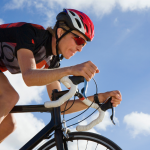5 injuries you didn’t think you could get from cycling
1. Runner’s knee
Yes, I said it! You can get runner’s knee from cycling. Contrary to popular belief, this painful problem is not confined to those who hit the pavements in their trainers alone. In fact, there’s a growing number of cyclists that land up on my treatment table that have been plagued with this pesky problem. The problem with cycling (cue “gasp” from our lycra-clad friends) is that the answer may not always be straight forward.
The ITB is a fibrous connective tissue that starts at the iliac crest (pelvic bone) and inserts into the tibia (leg bone) and patella(knee cap).It runs along the outside of your thigh and also provides the attachment site for your largest buttock muscle, gluteus maximus.
The ITB helps you extend your knee, flex and internally rotate the hip joint.
In cycling, overactive hip flexors and adductors accompanied by weak hip extensors and abductors are often the primary biomechanical source. Add to this the plethora of common bike set up failures such as cleats being too close together or a high riding seat or indeed an overly upward inclined seat and the risk factors are multiplied.
2. Neck strain
If most of your day entails sticking out your chin at a screen sitting behind a desk and is then followed by “relaxation” time craning your neck into cyberspace, then be sure to pay special attention to your neck flexibility. Some of the causes of a neck strain are from excessive neck extension as a result of poor thoracic flexibility, your seat too far back or you handle bars too low or far forward.

3. “Dead pinky” finger
Perhaps it started when you were white knuckling down Box Hill or possibly when you forgot to wear your cycling gloves? Numbness and tingling in your little (“pinky”) finger could be a result of ulnar nerve compression. This same nerve accounts for the not-so-funny “funny bone” experience when you bash your elbow. The ulnar nerve lies quite superficially at the outside part of your wrist and direct compression to it from your handle bars can cause tingling or numbness. There are numerous adjustments that can be made, from changing your hand position to changing your gloves or handlebars to prevent this problem. You should never guess, see a physio who will be able to tell you whether the tingling is a simple compression from a poor bike set-up or something that would benefit from treatment.
4. Lower back pain
Many an ex- marathon runner has turned to the aerobic cousin of running for respite from agony inflicted on damaged lumbar discs by running. The pounding of road running on lumbar discs has been well documented with the resultant axial pressure on the discs attributing to lumbar disc related low back pain. The advantage of cycling is in the fact that it offers a great alternative with similar cardiovascular benefits to running with significantly less impact on your back and other weight bearing joints.
If however there is some nerve root involvement to your back, cycling can provide relief as the resultant position of flexion facilitates an “opening” of the exit of nerve roots from the spinal cord and thus provide relief. But as you straighten up again into the upright position the pain can recur. Again bike set up is crucial. A seat that’s too high can cause you to shift excessively from left to right as you pedal dawn. Weakness in your “core stabilisers” can also cause excessive lumbar and pelvic movement too.
Physiotherapy can help to improve spinal flexibility and give you the important tools to correct your spinal mechanics and thus provide you the tools to create the platform of dynamic strength and flexibility required to make cycling both enjoyable and long lasting.
5. Foot numbness
Shoes shoes shoes… So if the shoe fits, wear it right? Wrong! Some poorly designed cleats that attach to your shoe’s innersole will cause direct compression to the sole of your foot. This excessive pressure can push on nerves in your foot leading to pins and needles, tingling or numbness. Narrow fitting shoes will also cause you problems on longer or harder rides as the foot swells up a little. Furthermore if you suffer from diabetes or any other medical condition, foot numbness should never be ignored as it may be connected with a systemic problem too.
See us at Vitality Physio, don’t leave it to chance, we have a wealth of knowledge that will stop the viscous cycle of pain, gear you up and help you get the pedal power you deserve!
